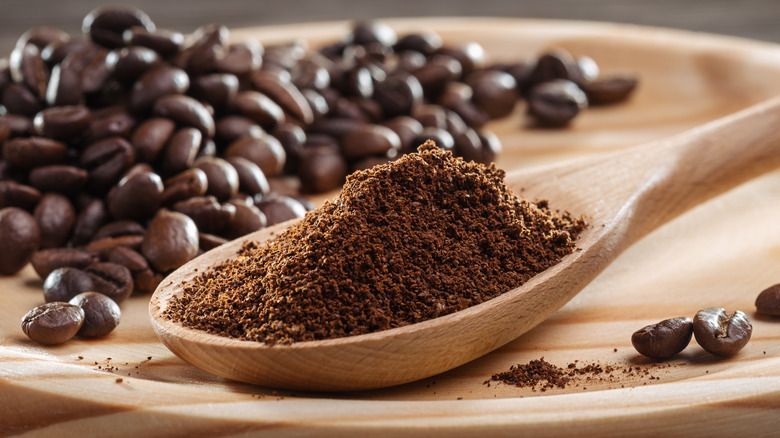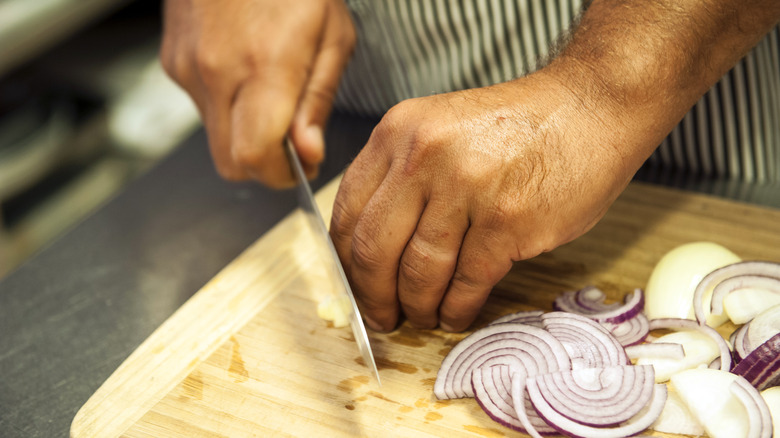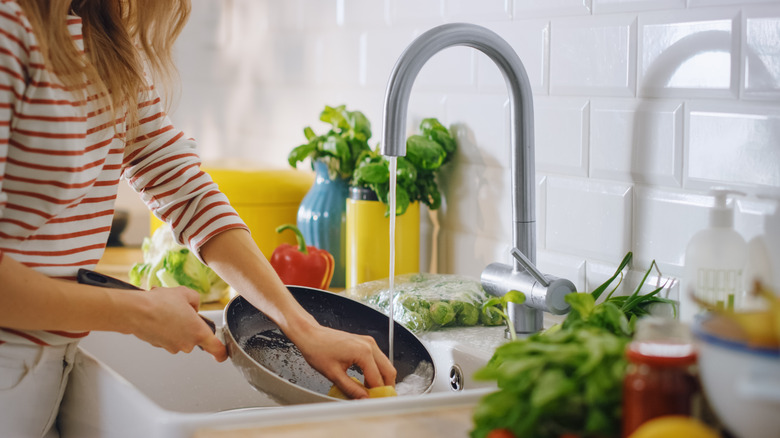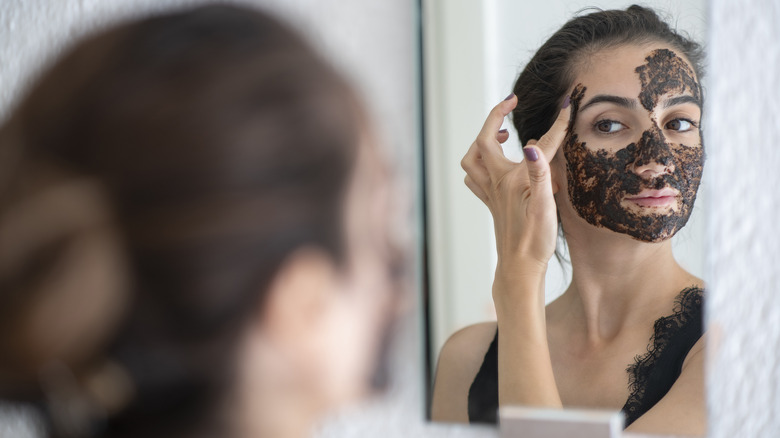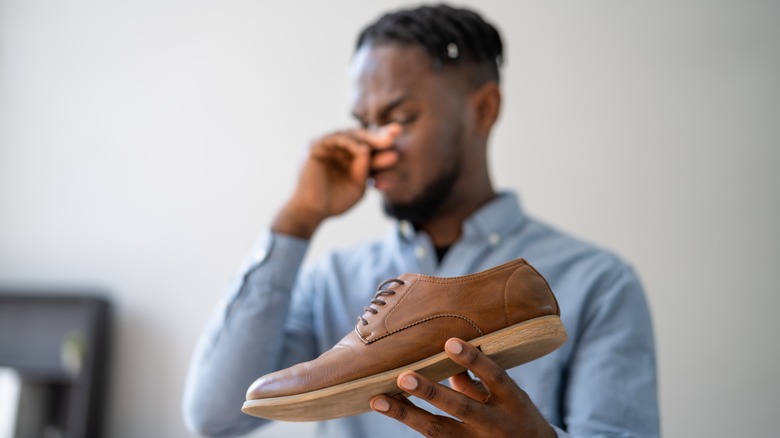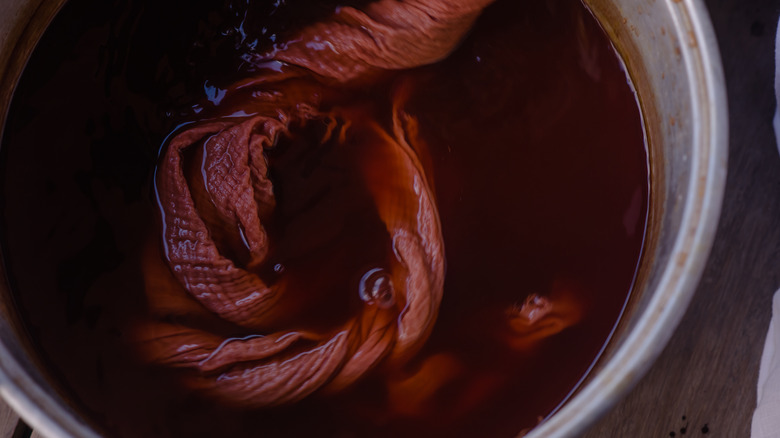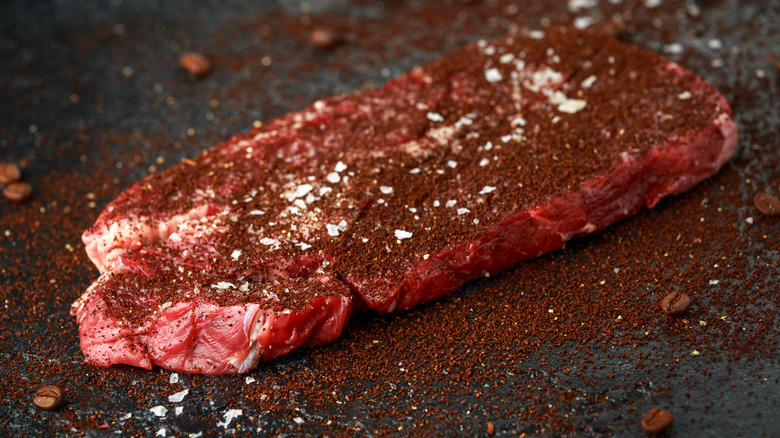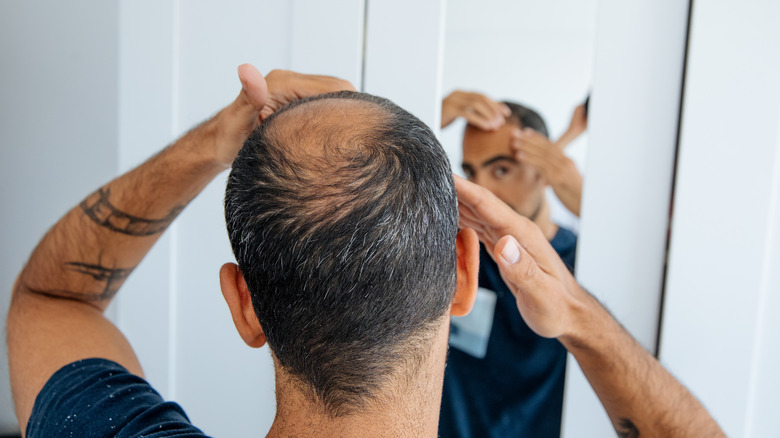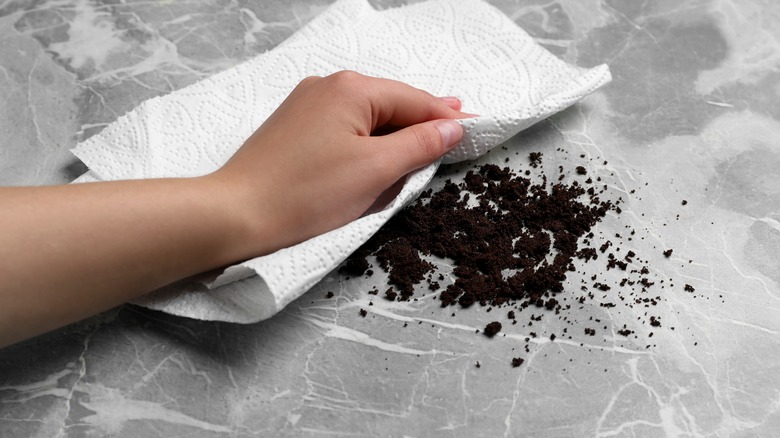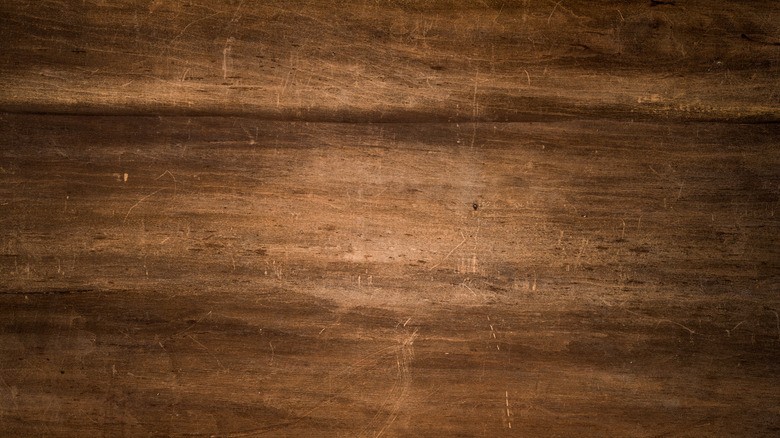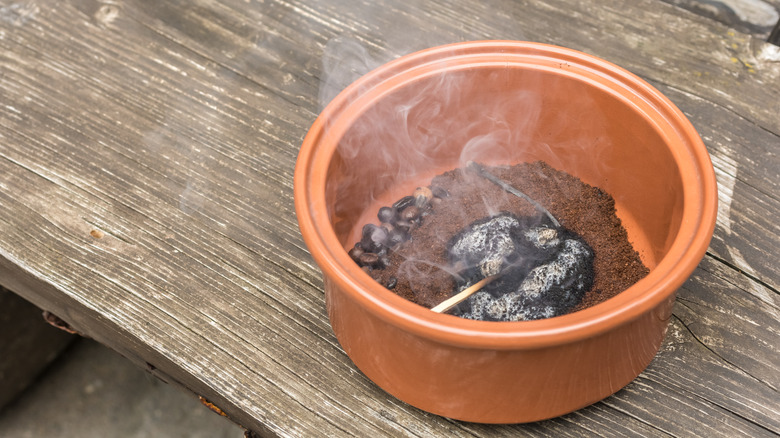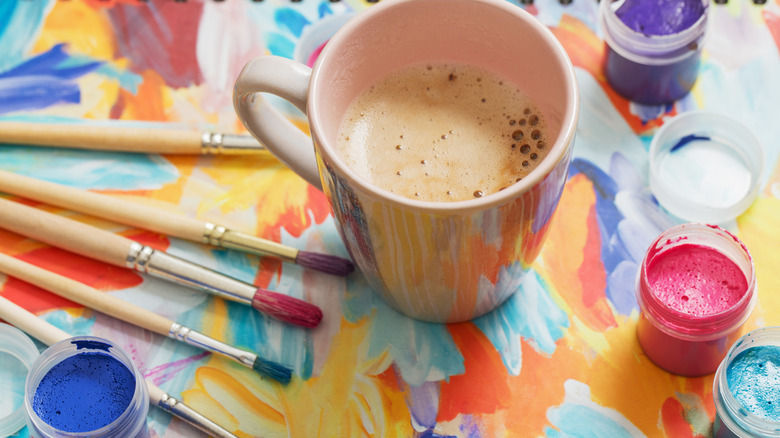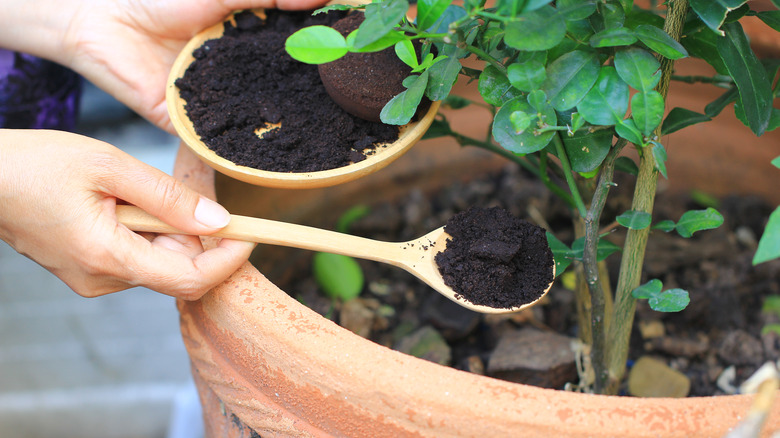13 Surprising Uses For Coffee Grounds You Should Know About
Drinking coffee is part of the morning routine for many of us. About three out of four Americans drink it daily, according to statistics gathered by Drive Research, and about two-thirds brew it at home. With all those spent coffee grounds, we're guessing a vast portion winds up in the trash. Yet beyond the many ways to upgrade your morning coffee, there is also a multitude of ways to repurpose used coffee grounds. So before you toss them, give us a chance to convince you why you should hold onto them and maybe even buy coffee grounds more regularly.
Between the acidic properties, vitamins, antioxidants, caffeine, and anti-inflammatory qualities found in coffee, it is understandable that the beverage can do a lot of good for your body — if consumed in an appropriate way, of course; we've probably all experienced some extreme caffeine jitters and side effects. But it may surprise you to learn what else coffee can do. Here, we'll explore the wide range of innovative ways coffee grounds can be incorporated into your other household routines, from enriching your garden to creating all-natural beauty products.
1. Decrease odor in your fridge with coffee grounds
Funky-smelling fridges are nothing new — it happens in the best kitchens. The good news is you can recycle one mess — wet, used coffee grounds — for this stinky situation. Because of the nitrogen found in coffee, the used grounds can actually help neutralize odors. As Science Daily explains it, coffee is caffeine-rich, as we know, and caffeine consists of nitrogen; nitrogen acts as a natural booster for carbon's process of adsorption, which is how carbon removes sulfur, a common cause responsible for noxious odors.
To use coffee grounds to eliminate the foul smell in your fridge, begin by drying them out, then put them in an open container and set them on the refrigerator shelf. Remember though, that natural odor eliminators such as coffee grounds or vinegar are already strong-smelling so by using them to get rid of foul smells, you're also inviting their scents to take over the fridge.
2. Coffee grounds can minimize the smell of garlic or onions on your hands
Even though you should be saving your garlic and onion peels, after chopping them up, the smell always seems to stick on your hands, often long after you're finished in the kitchen. Because coffee grounds can help neutralize and absorb unpleasant odors, they are an effective way to tackle the potent scents of foods such as fish, garlic, and onions.
To eliminate the perpetual smell of garlic or onion while cooking, simply take a handful of coffee grounds — fresh or used will suffice — and massage them onto your hands, paying special attention to the areas that touched the food, like your fingers and under your nails. After scrubbing for a solid minute or so, rinse with water and follow up with soap to fully rid yourself of the smell. This trick is so handy that it's worth leaving a spare container of coffee grounds next to the sink so they're readily available when you begin prepping your food.
3. Clean your pots and pans with a coffee ground scrub
Cooking with coffee isn't entirely new, but how about using coffee for the mess left behind? For an eco-friendly method to scrub away tough residue on your pots and pans, try using coffee grounds. Because of the naturally abrasive texture, they work well for scouring, especially cast iron skillets. You can use only the grounds, or you can mix a small amount of soapy water to make your scrub. If you're scouring cast iron, it might be best to forgo the soap unless you're facing something the rough grounds can't fight alone. But this trick won't work for every pot and pan — if it's ceramic, it may scratch the surface. Even though ceramic is tough, hard scrubbers like steel wool (or coffee scrubs) are known to cause damage.
While the texture plays a large role in how effective a coffee scrub is, the acid in coffee also lends a hand to the cleaning. According to Healthline, the beverage is quite acidic and the finer the grounds, the more acid a cup of brewed coffee might have. Keeping this in mind, if you use spent coffee grounds that are very small, the increased acid could help with cleaning even more.
4. Coffee grounds can be used to exfoliate and clean skin
Because of its rich antioxidant content, coarse texture, and general ease when using, coffee has become a popular natural remedy for skin care. Coffee grounds help remove dead skin cells by acting as an exfoliant, leaving you with softer skin.
To whip up an effective face scrub at home, simply mix some coffee grounds with an equal amount of olive oil or coconut oil, both of which provide additional moisture for your skin. For more of a paste to apply as a face mask, add a little water until the mixture holds enough to stay on your skin. Gently rub the mask, or scrub the oil-coffee blend, onto your face before rinsing it off with water.
Additionally, when coffee is applied to the skin, the antioxidants can produce a soothing effect. Beyond that, the chlorogenic acid (otherwise known as CGAs) present in coffee is related to its anti-inflammatory properties, and can potentially reduce acne and hyperpigmentation, as noted by Healthline. To take advantage of this, leave the mask or scrub on your face a little longer before washing it away.
5. Deodorize your shoes with coffee grounds
You can bypass the hassle of messy powders by sprinkling fresh coffee grounds into your shoes as a natural and effective way to absorb odors. Shoes tend to get particularly miasmic because of the buildup of bacteria and moisture from sweat, which cause unpleasant odors that are persistent long after the sweat is gone. An experiment published in Towards Data Science shows that coffee grounds are capable of absorbing quite a bit of water, suggesting they'll efficiently get rid of the moisture in shoes, as well. Aside from the porous nature of coffee grounds that allows them to act like tiny sponges, coffee also contains nitrogen, an organic deodorizer.
This process won't work with wet or used coffee grounds like some of these other solutions; you'll want to ensure they're completely dry before you get to work. Fill a pair of socks or small sachets (or makeshift ones with nylon pantyhose or coffee filters) with the coffee grounds and place them inside your shoes overnight. Not only are you left with odor-free shoes, but you've done so in an environmentally-safe way without using harsh or unknown chemicals.
6. Dye your clothes naturally with coffee grounds
If you're looking to get crafty, you can use coffee grounds to naturally dye fabric or yarn. Because of its natural hue, you're likely to get results in varying shades of brown, and each time it will look a little different.
Either fresh or spent coffee grounds will work. Start by placing the grounds in a large pot with enough water to cover your fabric entirely. You're essentially making a bath for your fabric to soak in. Bring the water to a simmer and allow the coffee to steep until it releases the color. After a little while, submerge the clothes in the pot and let it simmer in its bath for at least an hour, or until you reach your desired shade. (A little tip: The longer you leave the fabric in the pot, the darker the color will become). Once you're satisfied, carefully remove the warm fabric and rinse it thoroughly with water before letting it air dry. When dyeing fabric with natural ingredients, it's best to also use fabric made with natural materials, such as cotton, wool, silk, or linen.
7. Coffee grounds work as a meat tenderizer or marinade
Whether used as a tenderizer, rub, or marinade, coffee's acidity and complex flavor profile can help elevate your meat recipes. As far as what kind of coffee to go with, it all depends on the roast. If you're a beginner to the wide world of coffee beans, it helps to know a few basics. Dark roasted coffee tends to have a more bitter flavor and less acidity, while a light roast is not only more acidic but it usually has more caffeine. While the caffeine content won't matter when marinating or tenderizing meat, acidity is vital. Acidic liquids or foods can help break down the connective tissue in meat, so using a highly acidic coffee will certainly work well as a tenderizer, especially in tough cuts of meat like brisket, chuck roast, or steak.
Coffee can also add a unique flavor when used as a rub or marinade. Combined with other complementary spices and herbs, coffee gives a rich, smoky, and slightly bitter taste. Coffee rubs are often applied to meats before cooking, which can form a delicious crust as it cooks on the grill or roasts in the oven. By using a coffee-based marinade or applying coffee directly as a rub, the meat's fibers start to soften too, leading to a more tender and flavorful outcome. While there are a plethora of coffee-infused recipes, we suggest trying coffee-rubbed steak or coffee pot roast.
8. Coffee grounds can be a stimulant for hair growth
Using coffee grounds as a scalp scrub is a clever form of self care that includes a gentle yet invigorating massage that does two great things for your hair: It stimulates blood circulation and supports a healthier scalp, which in turn can encourage hair growth. This is because any kind of massage can enhance blood flow to the hair follicles, leading to improved circulation, which helps bring vital nutrients and oxygen to the hair roots, enhancing the overall health of your scalp and hair, Healthline notes.
Another reason this works is because of the exfoliating qualities of coffee, which helps to gently remove dead skin cells, excess sebum, and any product buildup that may clog hair follicles. If you're not convinced yet, the caffeine can also be beneficial for hair growth. In fact, a study in The British Journal of Dermatology showed that caffeine can inhibit the activity of DHT (dihydrotestosterone), a hormone that has been linked to hair loss.
9. Use coffee grounds as a multipurpose cleaner
To deep-clean various surfaces with an eco-friendly solution, try incorporating coffee grounds into your cleaning regimen. Not only are they gritty enough to face difficult dirt and grime, but they also have antibacterial properties that can aid in sanitization. When used with a sponge or cloth, they can help remove residue, especially on sinks, grill grates, and countertops. Just make sure to wipe them out of the sink instead of rinsing them down the drain because they could clog your pipes. Contrary to previous claims that running coffee grounds down the drain could break down grease in the same way it does on surfaces, coffee grounds are not water-soluble, so they can actually cause blockages.
Both caffeine and caffeic acid are present in coffee, and these natural substances can reduce harmful bacteria, creating an organic sanitizer. A study in Applied and Environmental Microbiology shows the positive effects of caffeic acid on bacteria (called "bactericidal activity") such as E. Coli and Salmonella. For best results, combine fresh coffee grounds — or make sure to hand-dry used ones — with dish soap and mix it together to create a paste that you can use to scrub down your kitchen counters and appliances.
10. Fix scratches on your wood furniture with coffee grounds
It may seem surprising that the same beverage that can produce stains can also repair your furniture, particularly if it's wooden. Truly, coffee grounds can work some magic on scuffs by cleverly concealing the damaged spots. To disguise scratches, take dry coffee grounds (either fresh or used) and form the paste by combining the grounds with vegetable or olive oil. Carefully apply the paste over the scratches, ensuring they are fully covered, and let it sit for upwards of 15 minutes. Once the time is up, take a soft cloth and gently buff the area until the paste is completely gone and the color blends seamlessly with the wood.
Another trick is to create a concealer for scratches by shaking up a mixture of coffee grounds with 1/4 cup each of warm water and vinegar. Use a rag to apply it to your furniture after letting the mixture steep for about an hour.
It's important to keep in mind that although coffee grounds can certainly help, they might not entirely eliminate deep or severe damage. In such cases, it may be best to seek professional furniture repair. Moreover, before applying coffee grounds to any furniture, it's wise to conduct a test on a small, inconspicuous area to check for undesired results.
11. Coffee grounds can be an insect repellent in your yard
Both burning coffee grounds as incense and sprinkling wet grounds in your garden are organic ways to help repel mosquitoes and other insects from your lawn. Between the strong smell, the color, and the components of coffee, it acts as a decent repellent. As explained by a study in Parasites & Vectors, coffee has qualities that are unattractive to mosquitoes and flies, plus caffeine can potentially inhibit a spider's capability to weave its web. Furthermore, it's possible for coffee to kill some unwanted insects and larvae. All of this aside, mosquitoes are also attracted to our sweat and the carbon dioxide we exhale, so this isn't a fool-proof method for the pesky biters.
Despite understanding that some mosquitoes might remain stubborn, we think it's worth a shot. Burning coffee grounds is fairly straightforward; just make sure to use a heat-resistant dish — like something metal or ceramic — to put the coffee grounds in before lighting them on fire. If you don't feel like playing with fire, you can spread damp coffee grounds around the base of plants or in areas where you want to repel insects.
12. Make homemade paint with coffee grounds
If you want to experiment with natural paint, coffee grounds can be transformed into various kinds of paints with distinct textures. You can make a simple watercolor paint by combining dried coffee grounds with water, resulting in sepia-toned artwork with a grittiness to the touch. The more water, the darker the shade of brown; the less, the lighter the shade. Additionally, you can incorporate coffee grounds into acrylic or tempera paint, delivering a rich color, depth, and visual texture to your artwork — you know, like for the perfect grain for tree bark or the ripples of chocolate frosting (yes, we're talking about painting food here, too)!
All of these easy and innovative ideas are also ways to create budget-friendly, homemade crafts with children. Whether you're wanting indoor fun on a rainy day, painting a picturesque landscape, or experimenting with imaginative textures, using coffee grounds for paint is a unique way to get artsy.
13. Use coffee grounds as fertilizer or compost in your garden
Coffee grounds offer valuable benefits for your garden by helping to regulate soil acidity while also providing nutrients that act as fertilizer. When used in moderation, they can positively impact plant growth, but if you use too much, they could cause balding in your garden, courtesy of a caffeine overdose. According to some studies, caffeine has been shown to impede the growth of roots, so take care not to go overboard.
If used correctly, which requires sprinkling damp grounds only in the areas you want it to affect, the slight acidity of coffee grounds is ideal for acid-loving plants like tomatoes, begonias, rhododendrons, and azaleas, as they help maintain an optimal pH balance in the soil. Additionally, they are an excellent source of nitrogen, phosphorus, and potassium, all of which are considered fundamental macronutrients for promoting soil health. According to the University of Wyoming, they consist of "2% nitrogen, 0.06% phosphorus, and 0.6% potassium by volume." These nutrients gradually release into the soil as they decompose, acting as a slow-release organic fertilizer for various plants, especially nitrogen-demanding species such as corn, tomatoes, lettuce, spinach, and sunflowers.
